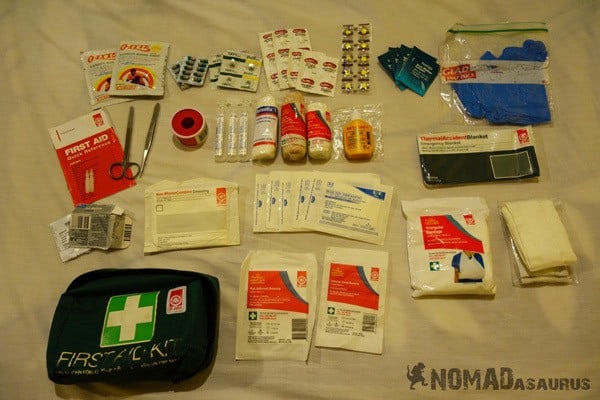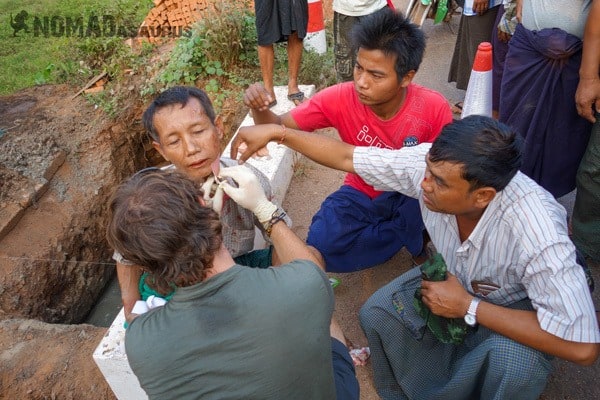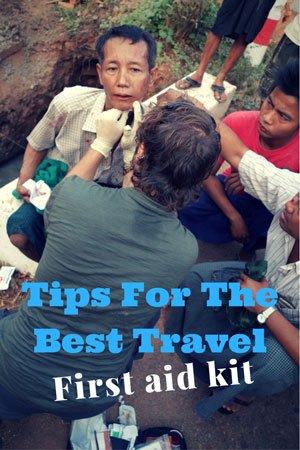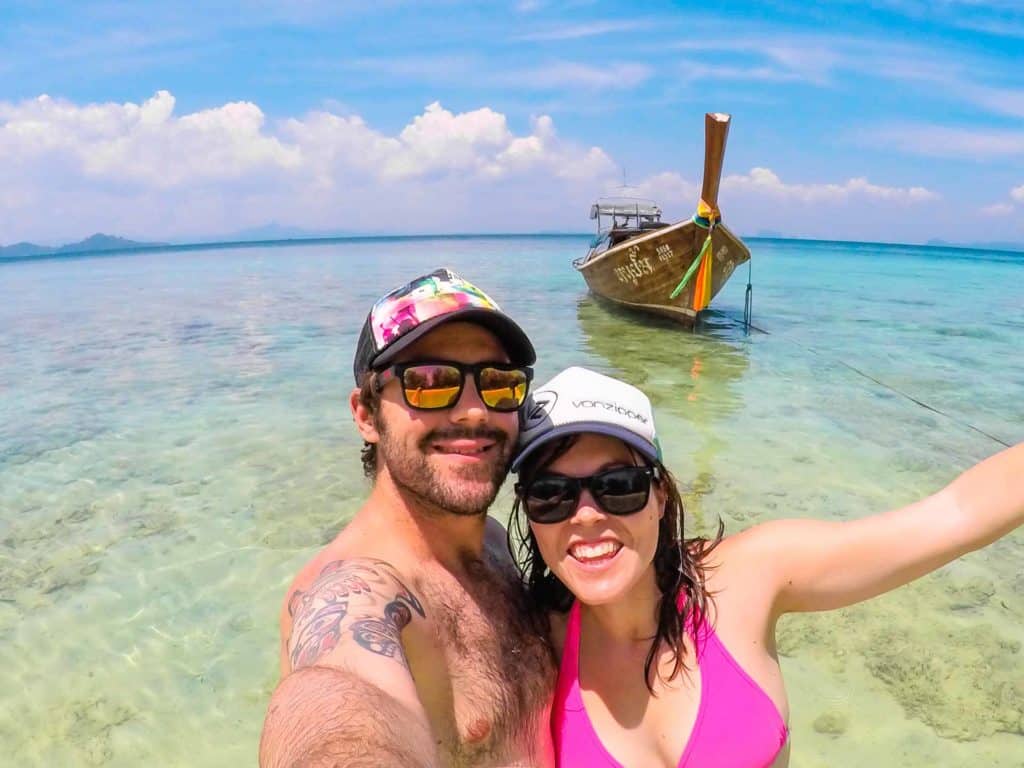Even though travel is normally a tonne of fun and very little ever actually goes wrong, you should still always be prepared. Little things like cuts, blisters, bruises and grazes are inevitable. There is also a chance you may get sick and sometimes you may be a long way away from a doctor or medical care.

It is always a good idea to have your own basic first aid kit. We never travel without one and it has come in handy in all kinds of situations. I used to volunteer with the St John’s Ambulance in Australia as an unpaid ambulance officer and learnt so much about first aid kits, skills and equipment during my time there. Here is my little guide about things you need to know, what you should pack and other tips for your travel first aid kit.
Table of Contents
What You Need For Your Travel First Aid kit
- First Aid Quick Reference Hand Book – If you are prone to having mind blanks, or are afraid you might forget an important piece of information under a stressful situation, carry one of these hand books. Will give yourself or a bystander some great tips.
- Disposable Gloves – It is very important to have these in your first aid in order to protect yourself and the patient from spreading diseases. To be safe always put them on if you are applying first aid, even if there is no open wounds.
- Scissors – Great for everything, to cut bandages/ tape, clothing if need, etc.
- Tweezers – What you need for removing larger splinters, metal shavings, etc.
- Safety Pins – Great for pinning bandages or holding your clothes together. Sometimes you can even use them to keep your pants up!
- Splinter Removal Tool – Easiest and cleanest way to get out a splinter out if you are uncomfortable with using tweezers.
- Saline Solution – Great for an eye rinse or to clean out a wound. Can even be used as contact solution if you run out unexpectedly.
- Band Aids – Good for small cuts, blisters, and much much more.
- Alcohol Wipes – To disinfect a wound quick and easy, as well as sterilising tweezers and other metal objects. Single use.
- Thermal Blanket – I know some might not think this would be useful. We have never used our one personally, but if we ever needed one we would definitely want it handy. We do a lot of trekking and hiking in different areas, sometimes with a guide, most of the time without and you never know what could happen. If you find yourself out in remote areas it could save your life. We love snowboarding and Jazza does a lot of overnight trips. It is not big and bulky and weighs hardly anything so I always have one in our kit.
- Dressing Tape – To be used to keep a dressing on or to bandage body joints.
- Wound Dressing – The gauze pad cushions and protects the injury, preventing dryness in an open wound. Do not place the gauze pad directly onto the wound as they may stick, however they do allow blood and fluids to pass through and be absorbed.
- Non-Adherent Pad – This sterile, absorbent pad will not interfere with granulating tissue by sticking to the wound. The soft perforated film allows air to circulate and the absorbent pad allows the fluid to collect. It can easily be cut to fit any shape without separating.
- Elastic Support Bandage – An ideal bandage where support, immobilisation & pressure is required.
- Triangular Bandage – Great for a sling bandage, donut bandage, firm bandage, and more. If you hurt your arm or shoulder, this is a saviour. If you don’t know how to apply one check out this video:
Medication
- Malarone
These are a treatment for malaria. Because we are travelling for so long we decided to not take any malaria tablets. We talked to some doctors who suggested that it would actually be worse for our bodies if we took malaria tablets for a long period of time rather than getting malaria itself. We did our research also and agreed. This does not cure malaria if you get it. It will buy you some time to get to the hospital and be treated properly. - Paracetamol
Pain killers are always great to have in the kit. Jazza is not a fan, but I will get him to take them when he is in a lot of pain. We do not use them a lot but when we do they do there job. Don’t take advantage of them. These are easy to pick up at any pharmacy. - Motion Sickness Tablets
Now if you are travelling in those crazy buses in Asia or Latin America you know just how hectic they like to drive. We usually don’t get motion sickness but when others around us do and are throwing up, we take them. They are so cheap and easy to stock up on. Most pharmacies and many major bus stations will sell them. - Electrolyte Powder Satchels
When you travel and try different foods that you are not used to, you may get sick. You may be very active, trekking long distances and don’t consume enough food and water to stay adequately hydrated. These satchels are great to put the electrolytes back in your body. Don’t use them too often though as they can be bad for you if taken excessively. Only when you really need it. - Itch Relief Cream
We used this one a lot in sand fly areas. They get your ankles and feet and then the scratching begins. Good for mosquito bites as well.
- Tiger Balm
We love to hike and trek and sometime our muscles get sore. Tiger balm is perfect for this. If you are getting sick it is a great chest rub and to put a little under the nose to clear you up. - Vaccinations
Ok, getting vaccinations for travel is something you do before you leave home, but it’s still important to consider what you need. Lots of countries won’t let you in if you don’t have proof of your Yellow Fever vaccination, so make sure you do your research.
Don’t Forget To Look After Your Wounds

They could be from a little insect bite to an injury from a bicycle or scooter. You need to take care of them. It is so easy for your wound to get infected. It may get infected by the smallest germ, dirty water or you not looking after it correctly. Let your wound air. Keep your wound dry as much as possible. I know when you are near an ocean it is hard as you are swimming a lot, but air it out between swims.
Change the gauze/bandage daily, twice a day if needed. Clean it twice daily if you can. Salt and purified water is a great mix. Let it air, then put some iodine on it with a bandage.
I have seen many foreigners go to hospital because their wound got infected. They are out a few days, in more pain and sometime have to deal with their insurance company to be reimbursed. In a worst case scenario, some people even have to cancel the rest of their travels.
I got a really bad exhaust burn from one of our motorbikes. I thought, “This is going to scar really badly”. I took care of it, cleaning it twice daily. Changing bandages regularly, even after swims. I went through a lot of gauze. Now that is healed you can only see the slightest little scar.
Learn Basic First Aid
In most developed nations we are lucky enough to be able to take a basic first aid course. In my opinion these are absolutely essential and very important. You never know when you may need to use your first aid skills. A lot of it is common sense but it is helpful to do a proper hands-on course so that in a stressful situation the knowledge comes back to you easily. If you are stuck for time and cash you can even find free online first aid courses.
Bonus Tip For The First Aid Kit – Lavender Essential Oil
This awesome essential oil is good for so much. It is often recommended to use “neat” (this meaning directly on applying) in case of emergency. I would recommend diluting any essential oil before applying to your skin as they are extremely strong and can be harmful. But in an emergency there are many successful uses for lavender oil undiluted. Everyone’s skin is different, some more sensitive than others. I personally put my lavender undiluted and it is fine for my skin. Don’t use a lot, only a few drops at a time.
I have it in my kit for:
- Stress – rub 2-3 drops into your palm or tissue and inhale. I find the best way for me is to rub a few drops into my temples and this has a more immediate effect.
- Sleeping Aid – same as stress but you can add a few drops to your pillow.
- Perfume – my toiletry bag is full enough, let alone putting a perfume bottle in there. So I have a little spray bottle and put as many drops as needed with purified water and there you go, perfume. It doesn’t last hours and hours. Essential oils evaporate fast, but it makes me feel good and refreshed.
- Shoe Odour – yep sometimes our shoes get a bit stinky. I find a couple drops of lavender and some air time does the job.
- Period Pain And Headaches – I rub a few drops on my temple or lower tummy.
But there is so many reasons to have lavender in your kit. Other uses are:
Bee stings/Insect bites, minor burns, cuts, eczema/dermatitis, nausea or motion sickness, nosebleed, dry or chapped skin and lips, hay fever, dandruff, cold sores
As you can see from above this little essential oil is my favourite. Natural lavender is an essential oil that can uplift your life (and mood), heal and entice in a variety of ways. It’s a great secret weapon to have on hand at all times.
[box type=”info” size=”large” style=”rounded” border=”full”]What would you add to your travel first aid kit? [/box]
Pin It For Later



18 thoughts on “Tips For The Best Travel First Aid Kit in 2025”
Nice post and helpful in creating our first aid kit. It is an important part while traveling to manage our first aid kit as well. Thanks for the info.
Totally agree. When we stop for a bit, I always go through our first aid kit to check what we have and what we need. Glad you enjoyed the article.
Great post! First Aid is something too many people don’t take seriously enough. Not major stuff, but at least a few Band Aids and some antiseptic. One thing we always carry is ginger – in the form of chews or dried ginger. It’s helpful for easing a queasy stomach.
Very true. Ginger is a great idea. We used it a lot recently and were so glad we had it. Thank you for sharing. 🙂
Nice Post!
Thank you
have you ever needed to use water purification tablets? I was thinking about bringing those along just in case (especially when in more rural regions while trekking), but are they not truly necessary or easily found over there?
Hi Kaitlin, We have. We have swapped to a UV steriliser now. We used it a lot through China, Mongolia and Central Asia. It was great to have when we were hiking. If you are in Southeast Asia there are filtration machines on the streets that we used regularly or you can buy up to 6 litres from convenience stores. We have never looked for the tablets travelling but I am sure you can get them from a pharmacy.
Hi guys!!
Great article, we are heading away in the new year and will be ticking off our first aid kit based on this!! Just wondered when you say you aren’t taking malaria treatment how long is too long to take it for. We will end up taking it for about 5 months but going with doxycycline instead of malarane? does this sound like too long, hard to get someone to tell you straight!!
Love the website, very inspirational!!
Lavina
We asked ours at the time and we thought we were going to be in a malaria affected area for over 6 months. His opinion was, taking the tablets for that period would be worse for our bodies than getting malaria. We went with him and haven’t been on any for the last 3 years.
But please ask your doctor what their opinions is. We are not medical professionals.
Another great all-rounder thing to have in your bag (first aid or beauty, whichever tickles your fancy) is pure Coconut Oil. That shit does everything; helps heal scars faster (and for stretch marks), great for dry skin or dry hair, massage oil (wink, wink), kills fungal infections (how annoying is that thrush, ladies?), shave cream and aftershave, cooking oil, make-up remover, tanning oil/sunscreen (has natural SPF+4), like literally everything!
I think between the Lavender Oil and Coconut Oil we’ll have pretty much everything covered 😀
We love coconut oil! We don’t travel with it, but used it a lot when we were back in Australia. It is the only oil Jazza will cook with, and he used to eat a spoonful before a workout for some energy. I (Lesh) love my lavender oil though. Could never travel without it. Thanks for reading Crystal 🙂
Thanks for posting this, guys! I’m getting ready to start my first big overland backpacking trip (through Central America) so am working on compiling a kit myself in the next week or so, this was super helpful info.
Do you have any advice of the tops of your heads on where the electrolyte packets are easy to find (in the US at the moment)? After a quick Google search it looks like they may not be stocked at typical drug stores…
Hey Jakob. No worries at all. Thanks for reading! You’ll love Central America. Such a fascinating part of the world. Can’t think off the top of our heads where in the US you can get them, but don’t worry – you can buy them quite easily in Central America! Just wait til you get there and buy some from a pharmacy or corner store. Happy travels!
Great article guys!! My first aid kit is very very basic. I was actually just talking to my mum about this earlier, thinking I should probably be a bit better prepared…perfect timing! How much room does this little box of tricks take up? Thanks for sharing, really useful!
Thank for reading, Rich. It doesn’t take up that much room. Probably measures about 15x10x10cm. Something that we would always make room for. Glad the article came at the perfect timing for you. Good luck on the next adventure!
I just realized that the first aid kit I carry while travelling is a joke!
Thank you, this is an incredibly useful post that I’m going to bookmark and share with my readers.
Cheers,
Natasha
Thanks for sharing it, Natasha. We believe it’s something everyone should travel with. Never know when it will come in handy 😀